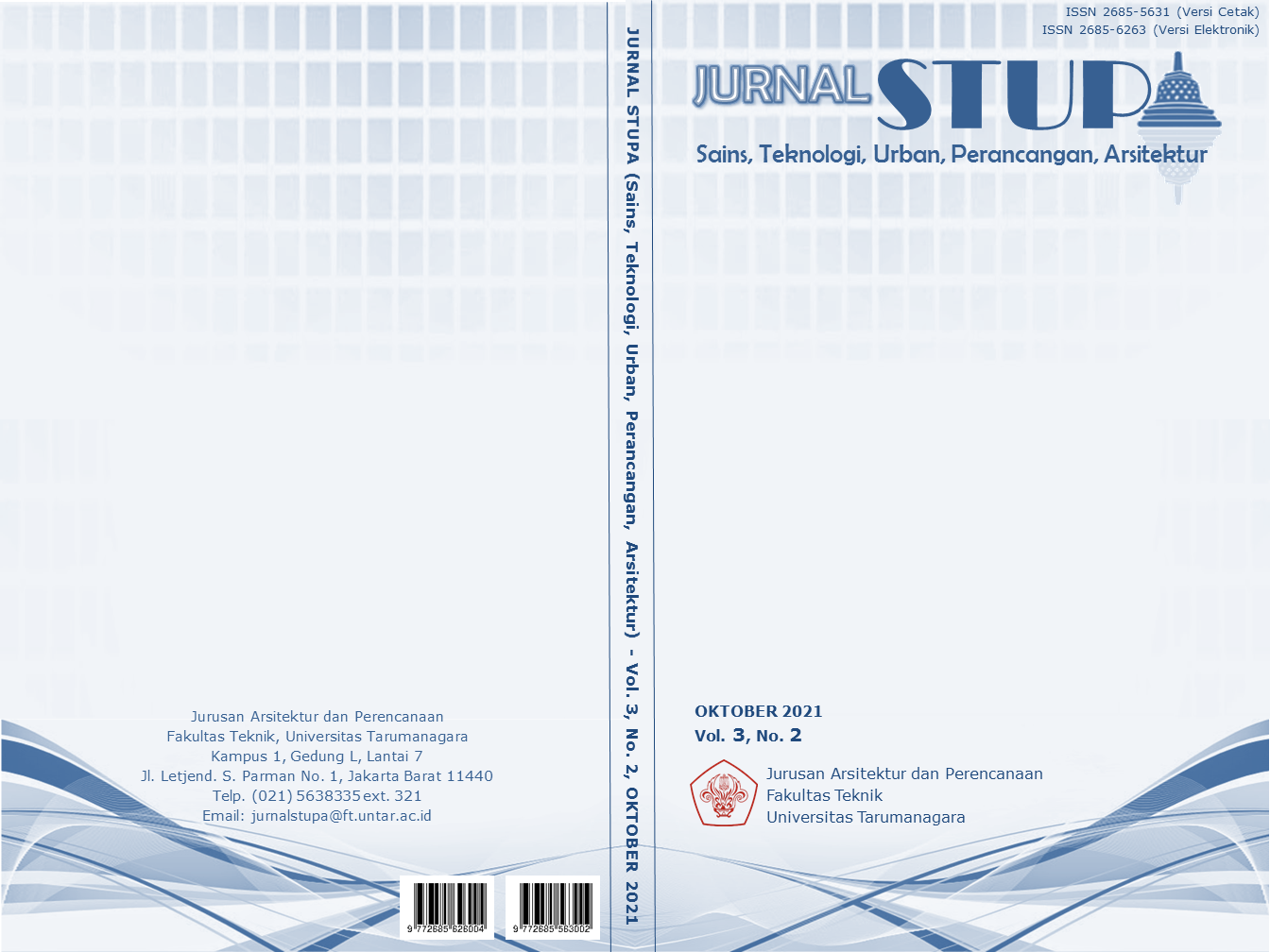RUANG KOMUNAL BARU: PERANCANGAN FASILITAS KOMUNITAS (REKREASI-RELAKSASI-KEBUGARAN) DENGAN PENDEKATAN ARSITEKTUR BIOFILIK DI PLUIT, JAKARTA UTARA
Main Article Content
Abstract
Cities are now the preferred place of residence for half the human population. The city itself is part of the ecology in which there are various systems. The reason residents choose to live in the city is the many supporting facilities and opportunities for growth. However, this does not guarantee that humans are always happy, there will be many problems that occur as time and time change so that it can cause stress triggers. Especially since the pandemic has impacted people, they are required to work or attend school from home. Living in a city with overlapping residences, the lack of open lands, such as apartments or housing, will make people feel that space is increasingly limited. Based on this, we need a space that can reduce stress. The goal is to create a new communal space as a place to interact to form a community to provide social support to each other with environmentally friendly designs, one of which is by applying biophilic designs. The application of biophilic can help humans improve the quality of life in terms of psychology and has a characteristic that combines natural patterns into buildings to reduce stress. The community can use this new communal space, especially those living around the site, with the main program providing easy-to-reach public space facilities. These facilities include work and study, a place for psychological consultations with professionals, communities such as gardening, cooking, workshops, as well as recreational facilities such as jogging, swimming, salon, cinema.
Keywords: biophilic; city; community; stress; wellness
Abstrak
Kota saat ini menjadi tempat tinggal yang dipilih bagi separuh populasi manusia. Kota sendiri termasuk bagian dari ekologi yang di dalamnya terdapat berbagai sistem. Alasan mengapa penduduk memilih untuk tinggal di kota adalah karena banyak fasilitas pendukung dan peluang untuk berkembang. Namun, hal tersebut tidak menjamin manusia selalu bahagia, akan banyak masalah terjadi seiring perubahan masa dan waktu sehingga dapat menyebabkan pemicu stress. Apalagi sejak terjadinya pandemi yang berdampak pada masyarakat diharuskan bekerja maupun bersekolah dari rumah. Tinggal di kota dengan tempat tinggal yang saling berhimpitan, kurangnya lahan terbuka, seperti apartemen maupun perumahan akan membuat masyarakat merasakan ruang semakin terbatas. Berdasarkan hal tersebut, diperlukan ruang yang dapat menurunkan tekanan stress. Tujuannya adalah membuat ruang komunal baru sebagai tempat berinteraksi membentuk komunitas untuk saling memberikan dukungan sosial dengan desain yang ramah terhadap lingkungan, salah satunya dengan menerapkan desain biofilik. Penerapan biofilik dapat berpengaruh membantu manusia meningkatkan kualitas hidup dalam hal psikologis dan memiliki ciri khas yang menggabungkan pola alam ke bangunan sehingga dapat mengurangi stress. Ruang komunal baru ini dapat digunakan oleh masyarakat terutama yang tinggal di sekitar tapak dengan program utama memberikan fasilitas ruang publik yang mudah dijangkau. Fasilitas tersebut antara lain untuk bekerja dan belajar, tempat konsultasi psikologis pada pihak profesional, berkomunitas seperti berkebun, memasak, workshop, maupun fasilitas rekreasi seperti jogging, berenang, salon, bioskop.
Article Details
References
Antonioli, M. (2017). What is Ecosophy? Schizoanalysis and Ecosophy: Reading Deleuze and Guattari, 74.
Burnett, S. (n.d.). Biophilic Design + Biomimicry by Shelby Burnett - issuu. https://issuu.com/shelbyburnett/docs/biophilic_design_book_-_shelby_burn
Contamination, E., & Resiliency, S. (n.d.). COVID-19: Addressing Community Stress and Resilience.
Dias, B. D. (2015). Beyond sustainability–biophilic and regenerative design in architecture. European Scientific Journal, 11(9), 147–158.
Ecosystems, M. E. A., & Well-Being, H. (2003). A Framework for Assessment. Millennium Ecosystem Assessment. Washington, DC: Island Press.
General Adaptation Syndrome: Your Body’s Response to Stress. (n.d.). Retrieved June 29, 2021, from https://www.healthline.com/health/general-adaptation-syndrome
Harsiti. (1992). Pusat Analisis Informasi Ekologi Perkotaan. Perpustakaan Universitas Indonesia.
Stewart, G. T. (1975). Stress in Everyday Life: (a) Stress in Society. Royal Society of Health Journal, 95(2), 65–69.
Heerwagen, J. (2009). Biophilia, health, and well-being. Restorative Commons: Creating Health and Well-Being through Urban Landscapes, 39–57.
Hernández, S. (2010). Eco-architecture III: Harmonisation Between Architecture and Nature (Vol. 128). WIT Press.
Sim, D. (2019). Soft city: building density for everyday life. Island Press.
The 7 Dimensions of Wellness | Mindbody. (n.d.). Retrieved June 30, 2021, from https://www.mindbodyonline.com/business/education/infographic/7-dimensions-wellness
The Mental Health Improvement For Stress-free Environment. (n.d.). Retrieved June 29, 2021, from https://www.smartcity.press/mental-health-improvement/
What is Wellness Lifestyle Real Estate & Communities? - Global Wellness Institute. (n.d.). Retrieved June 30, 2021, from https://globalwellnessinstitute.org/what-is-wellness/what-is-wellness-lifestyle-real-estate-communities/


